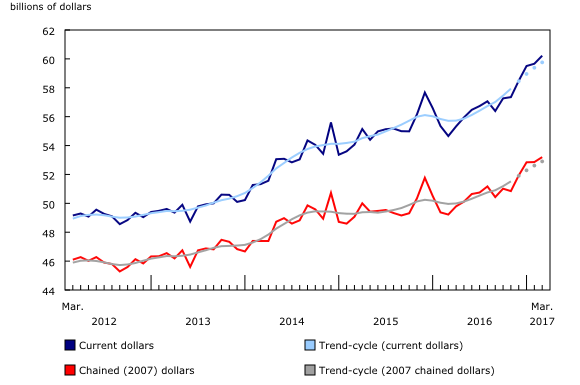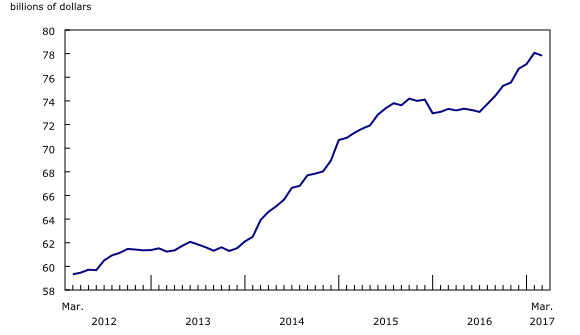Wholesale trade, March 2017
Archived Content
Information identified as archived is provided for reference, research or recordkeeping purposes. It is not subject to the Government of Canada Web Standards and has not been altered or updated since it was archived. Please "contact us" to request a format other than those available.
Released: 2017-05-23
$60.2 billion
March 2017
0.9% 
(monthly change)
$489.1 million
March 2017
29.3% 
(monthly change)
$74.4 million
March 2017
6.1% 
(monthly change)
$807.8 million
March 2017
1.8% 
(monthly change)
$508.0 million
March 2017
0.1% 
(monthly change)
$10,809.3 million
March 2017
1.1% 
(monthly change)
$31,009.6 million
March 2017
0.3% 
(monthly change)
$1,594.2 million
March 2017
-0.1% 
(monthly change)
$2,160.8 million
March 2017
1.4% 
(monthly change)
$6,441.8 million
March 2017
1.5% 
(monthly change)
$6,250.8 million
March 2017
1.9% 
(monthly change)
$22.0 million
March 2017
1.7% 
(monthly change)
$44.9 million
March 2017
-23.6% 
(monthly change)
$8.4 million
March 2017
15.2% 
(monthly change)
Wholesale sales rose 0.9% in March and surpassed the $60 billion mark for the first time. Gains were recorded in four of seven subsectors, accounting for 60% of total wholesale sales, and were led by the building material and supplies subsector.
In the first quarter of 2017, wholesale sales were up 3.6% from the fourth quarter of 2016. This was the highest quarterly change since the second quarter of 2008.
In volume terms, wholesale sales increased 0.6% from February to March.
Higher sales in four subsectors
The building material and supplies subsector recorded the largest increase in dollar terms, as sales rose 3.9% to a record high $8.4 billion on the strength of higher sales in the lumber, millwork, hardware and other building supplies industry (+5.7%) and the metal service centres industry (+8.2%). Exports of lumber and other sawmill and millwork products rose 6.0% in March.
Sales in the miscellaneous subsector rose 2.2% to $7.9 billion, following a 0.2% decline in February. Four of five industries contributed to the gain in March, with the chemical (except agricultural) and allied product industry contributing the most.
The food, beverage and tobacco subsector posted a second consecutive increase with sales growing 1.1% to $11.6 billion. Gains in the food industry (+1.1%) led the increase.
Sales were up 0.5% in the personal and household goods subsector, to $8.3 billion. While gains were widespread across the industries within the subsector, the personal goods industry (+5.0%) contributed the most.
The machinery, equipment and supplies subsector decreased 0.5% to $11.6 billion, following five months of increases. The construction, forestry, mining, and industrial machinery, equipment and supplies industry (-3.6%) contributed the most to the decline.
Sales in the motor vehicle and parts subsector edged down 0.2% to $11.6 billion as sales in the motor vehicle industry declined 0.5%. This was a second consecutive decline for both the subsector and the industry.
The farm product subsector (-1.6%) also declined in March.
Sales up in nine provinces
Wholesale sales were up in nine provinces in March, representing 97% of total wholesale sales. In dollar terms, British Columbia, Quebec, and Newfoundland and Labrador led the gain.
Following two consecutive declines, sales in British Columbia rose 1.9% to $6.3 billion, the second-highest sales level on record, primarily on higher sales in the building material and supplies subsector.
In Quebec, sales increased 1.1% to a record high $10.8 billion, led by the food, beverage and tobacco subsector. This was Quebec's third monthly increase in the past four months.
Newfoundland and Labrador recorded its first gain in four months, with sales jumping 29.3% to $489 million, the highest since November 2016. The miscellaneous subsector was the largest contributor to the increase.
Sales in Alberta rose 1.5% to $6.4 billion, a sixth consecutive increase. Gains were recorded in four subsectors, led by the motor vehicle and parts subsector and the building material and supplies subsector.
Ontario posted a fourth consecutive increase, with sales up 0.3% to a record high $31.0 billion. Gains in three subsectors, led by the building material and supplies subsector, offset declines in the other subsectors.
In Saskatchewan, sales were up 1.4% to $2.2 billion, with only the miscellaneous subsector posting a gain while other subsectors declined.
Sales in Nova Scotia increased 1.8% to $808 million, led by gains in the motor vehicle and parts subsector.
In Prince Edward Island, sales rose 6.1% to $74 million on the strength of gains in five subsectors, mostly offsetting a 6.0% decline in February.
Sales in New Brunswick edged up 0.1% to $508 million, led by higher sales in the building material and supplies subsector.
Manitoba recorded the lone decrease in March, with sales edging down 0.1% to $1.6 billion. Declines were recorded in five subsectors.
Inventories edge down in March
Wholesale inventories edged down 0.3% to $77.8 billion in March. Lower inventories in two subsectors, representing 45% of wholesale inventories, more than offset higher inventories in others.
The machinery, equipment and supplies subsector (-3.7%) posted the largest decrease in dollar terms in March, the first decline in eight months.
Inventories in the personal and household goods subsector were down 2.4%, the first decline in four months.
Inventories in the miscellaneous subsector rose 5.7%, reaching their highest level on record in March.
In the building material and supplies subsector (+2.0%), inventories increased for the fourth consecutive month.
The motor vehicle and parts subsector posted its second consecutive increase, with inventories up 0.8% to their highest level on record.
Higher inventories were also reported by the food, beverage and tobacco subsector (+0.9%).
The inventory-to-sales ratio declined from 1.31 in February to 1.29 in March. This ratio is a measure of the time in months required to exhaust inventories if sales were to remain at their current level.
Note to readers
Starting with the May 2017 release of March data, estimates for the Monthly Wholesale Trade Survey are being calculated using a new sample. The sample design has been modified to improve efficiency. The sample is periodically refreshed to take advantage of improvements made to the Business Register since the last sample selection, reflecting births, deaths and other changes to the survey population. In addition, the survey estimation methodology has been enhanced to use more administrative data. Seasonal adjustment specifications and factors were reviewed and updated.
Regular annual revisions from 2016 and typical historical revisions are also included in the new data series.
The data have been revised using historical linkage factors designed to preserve the continuity of the time series. The linkage method leads to larger revisions for more recent periods.
Seasonally adjusted estimates in CANSIM tables 081-0011 and 081-0012 have been revised back to 2009. Unadjusted estimates in CANSIM tables 081-0011 and 081-0012 have been adjusted back to 2012.
All data in this release are seasonally adjusted and expressed in current dollars, unless otherwise noted. For information on seasonal adjustment, see Seasonally adjusted data – Frequently asked questions.
Total wholesale sales expressed in volume are calculated by deflating current dollar values using relevant price indexes. The wholesale sales series in chained (2007) dollars is a chained Fisher volume index with 2007 as the reference year. For more information, see Sales in volume for Wholesale Trade.
The Monthly Wholesale Trade Survey covers all industries within the wholesale trade sector as defined by the North American Industry Classification System (NAICS), with the exception of oilseed and grain merchant wholesalers (NAICS 41112), petroleum and petroleum products merchant wholesalers (NAICS 412) and business-to-business electronic markets, and agents and brokers (NAICS 419).
For information on trend-cycle data, see the StatCan Blog and Trend-cycle estimates – Frequently asked questions.
Real-time CANSIM tables
Real-time CANSIM tables 081-8011, 081-8012 and 081-8015 will be updated on June 5. For more information, consult the document Real-time CANSIM tables.
Next release
Wholesale trade data for April will be released on June 20.
Contact information
For more information, contact us (toll-free 1-800-263-1136; 514-283-8300; STATCAN.infostats-infostats.STATCAN@canada.ca).
For analytical information, or to enquire about the concepts, methods or data quality of this release, contact Farzana Choudhury (613-218-0349; farzana.choudhury@canada.ca), Manufacturing and Wholesale Trade Division.
- Date modified:



